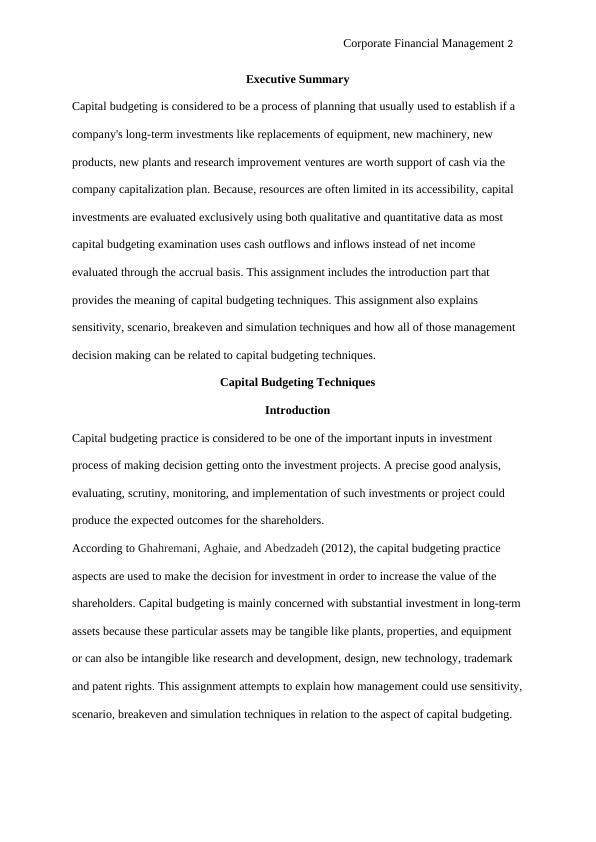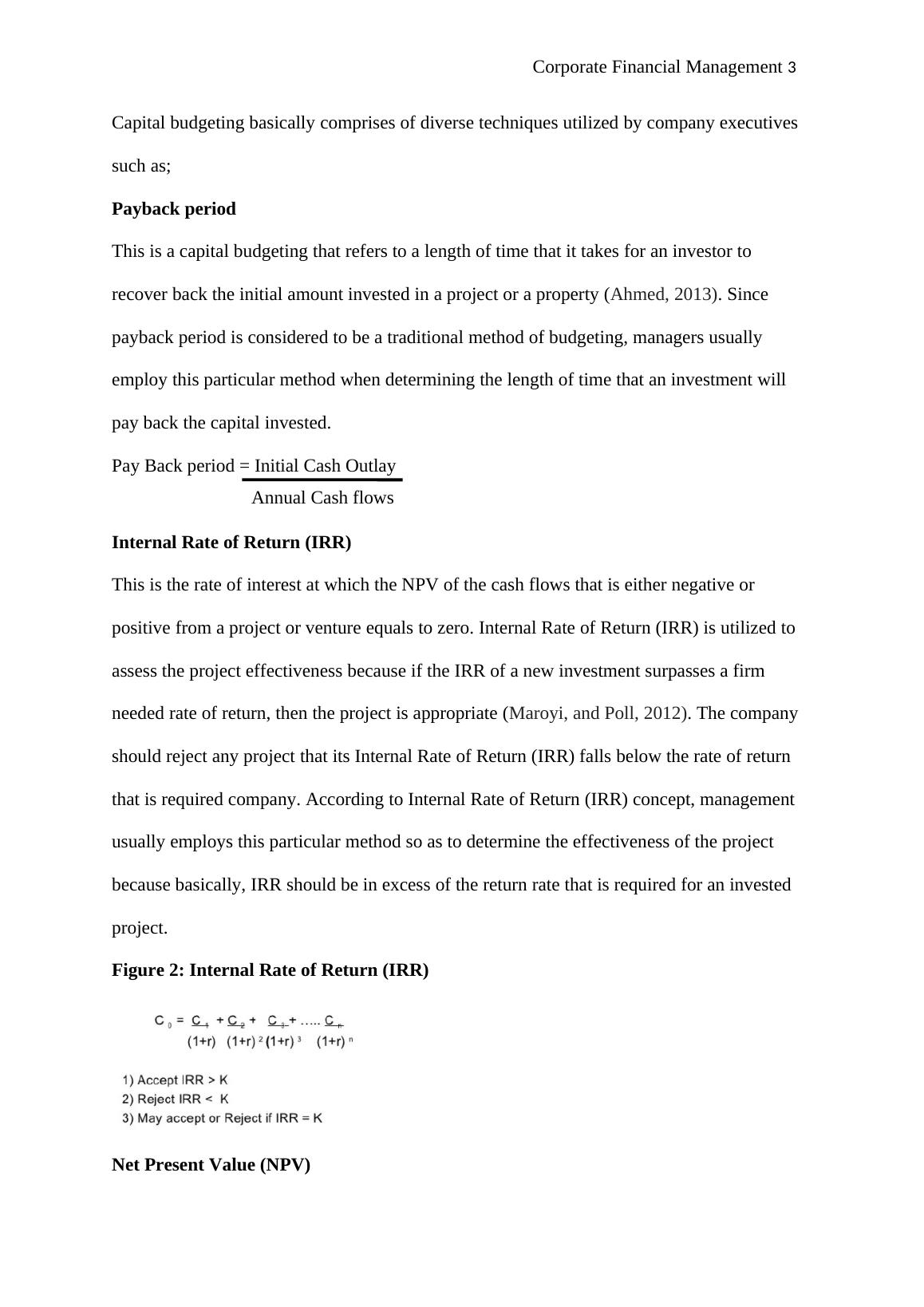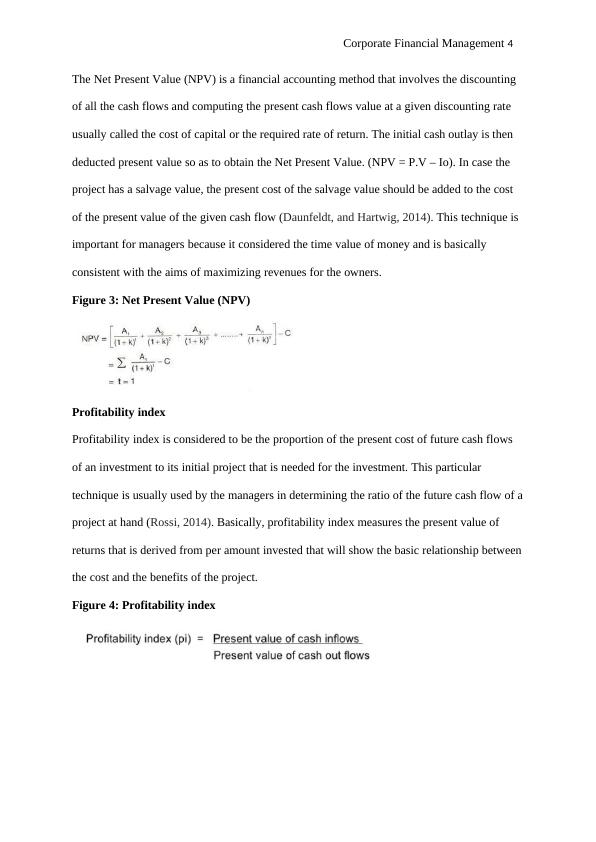Corporate Financial Management Assignment Capital Budgeting
12 Pages3009 Words181 Views
Added on 2020-04-07
Corporate Financial Management Assignment Capital Budgeting
Added on 2020-04-07
ShareRelated Documents
Corporate Financial Management 1CORPORATE FINANCIAL MANAGEMENTBy NameCourse TitleInstructor’s nameName of InstitutionName of Department

Corporate Financial Management 2Executive SummaryCapital budgeting is considered to be a process of planning that usually used to establish if a company's long-term investments like replacements of equipment, new machinery, new products, new plants and research improvement ventures are worth support of cash via the company capitalization plan. Because, resources are often limited in its accessibility, capital investments are evaluated exclusively using both qualitative and quantitative data as most capital budgeting examination uses cash outflows and inflows instead of net income evaluated through the accrual basis. This assignment includes the introduction part that provides the meaning of capital budgeting techniques. This assignment also explains sensitivity, scenario, breakeven and simulation techniques and how all of those management decision making can be related to capital budgeting techniques.Capital Budgeting TechniquesIntroduction Capital budgeting practice is considered to be one of the important inputs in investment process of making decision getting onto the investment projects. A precise good analysis, evaluating, scrutiny, monitoring, and implementation of such investments or project could produce the expected outcomes for the shareholders. According to Ghahremani, Aghaie, and Abedzadeh (2012), the capital budgeting practice aspects are used to make the decision for investment in order to increase the value of the shareholders. Capital budgeting is mainly concerned with substantial investment in long-termassets because these particular assets may be tangible like plants, properties, and equipment or can also be intangible like research and development, design, new technology, trademark and patent rights. This assignment attempts to explain how management could use sensitivity,scenario, breakeven and simulation techniques in relation to the aspect of capital budgeting.

Corporate Financial Management 3Capital budgeting basically comprises of diverse techniques utilized by company executives such as;Payback periodThis is a capital budgeting that refers to a length of time that it takes for an investor to recover back the initial amount invested in a project or a property (Ahmed, 2013). Since payback period is considered to be a traditional method of budgeting, managers usually employ this particular method when determining the length of time that an investment will pay back the capital invested. Pay Back period = Initial Cash Outlay Annual Cash flowsInternal Rate of Return (IRR)This is the rate of interest at which the NPV of the cash flows that is either negative or positive from a project or venture equals to zero. Internal Rate of Return (IRR) is utilized to assess the project effectiveness because if the IRR of a new investment surpasses a firm needed rate of return, then the project is appropriate (Maroyi, and Poll, 2012). The company should reject any project that its Internal Rate of Return (IRR) falls below the rate of return that is required company. According to Internal Rate of Return (IRR) concept, management usually employs this particular method so as to determine the effectiveness of the project because basically, IRR should be in excess of the return rate that is required for an invested project. Figure 2: Internal Rate of Return (IRR)Net Present Value (NPV)

Corporate Financial Management 4The Net Present Value (NPV) is a financial accounting method that involves the discounting of all the cash flows and computing the present cash flows value at a given discounting rate usually called the cost of capital or the required rate of return. The initial cash outlay is then deducted present value so as to obtain the Net Present Value. (NPV = P.V – Io). In case the project has a salvage value, the present cost of the salvage value should be added to the cost of the present value of the given cash flow (Daunfeldt, and Hartwig, 2014). This technique is important for managers because it considered the time value of money and is basically consistent with the aims of maximizing revenues for the owners. Figure 3: Net Present Value (NPV)Profitability indexProfitability index is considered to be the proportion of the present cost of future cash flows of an investment to its initial project that is needed for the investment. This particular technique is usually used by the managers in determining the ratio of the future cash flow of aproject at hand (Rossi, 2014). Basically, profitability index measures the present value of returns that is derived from per amount invested that will show the basic relationship betweenthe cost and the benefits of the project. Figure 4: Profitability index

End of preview
Want to access all the pages? Upload your documents or become a member.
Related Documents
Capital Budgeting Techniques Assignmentlg...
|14
|2489
|224
(PDF) Case Examples of Project Evaluationslg...
|6
|1278
|54
Capital Budgeting Analysis of ‘Real Time Translator’ project of Auditizz Electronicslg...
|10
|2053
|64
Capital Budgeting and Investment appraisal Technique in an Organizationlg...
|13
|2916
|456
Managerial Financelg...
|18
|3462
|484
Corporate Finance Assignment: Capital Budgeting, Sensitivity Analysis, Scenario Analysis, Break Even Analysis, Simulation Analysislg...
|13
|2258
|118
